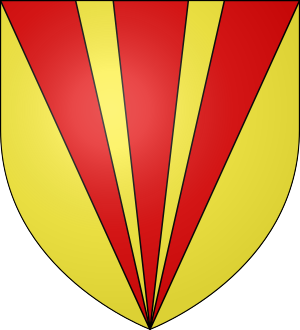David, Lord of Brechin facts for kids
Sir David de Brechin was a Scottish knight who lived a long time ago. He was involved in the big wars for Scotland's freedom, sometimes fighting for Scotland and sometimes for England. He died in 1320.
Contents
Sir David's Early Life
David de Brechin came from an important Scottish family. His father was Sir William de Brechin. His family was connected to some powerful Scottish nobles. We first hear about David in 1292. At that time, he was under the care of a knight named Sir John de Callendar.
Fighting in the Wars for Scotland
David de Brechin fought in the Wars of Scottish Independence. These were long wars where Scotland fought to stay independent from England.
Early Battles
In 1296, David fought for the English army at the Battle of Dunbar. After this battle, he was given land that used to belong to another Scottish noble. His name also appeared twice on the Ragman Rolls in 1296. The Ragman Rolls were lists of Scottish nobles who had sworn loyalty to the English King Edward I.
Joining Robert the Bruce
Later, David de Brechin joined Robert the Bruce, who would become King of Scots. David was with Bruce in Peebles when Bruce, John Comyn, and William Lamberton became the Guardians of Scotland. These Guardians were leaders who ruled Scotland when there was no king. David then went with Bruce to Galloway.
Fighting for Scotland Again
By 1301, Sir David was still active in southwestern Scotland. On September 8, he was part of a group led by Sir John de Soulis and Sir Ingram de Umfraville. They attacked Lochmaben Castle, and David was hurt during the fight.
Switching Sides Again
David de Brechin later returned to serving the English king. He showed his loyalty to Edward I of England during the Siege of Stirling Castle. This was a very important castle in Scotland.
He continued to serve the English. He was present at the Battle of Inverurie in 1308. A writer named John Barbour said that after this battle, David went to Brechin Castle. Barbour wrote that David Earl of Atholl then surrounded the castle. However, other historians say this is not quite right. The Earl of Atholl was still working for the English at that time. So, someone else must have captured Brechin Castle for King Robert.
A Key Document and a Conspiracy
On April 6, 1320, David de Brechin put his official seal on the Declaration of Arbroath. This was a very important letter sent to the Pope. It asked the Pope to recognize Scotland as an independent country.
Later that year, in August, a special meeting was held at Scone. This meeting became known as the Black Parliament. At this meeting, David de Brechin was found to be part of a secret plan. This plan was to remove King Robert the Bruce from power. Because of this serious act against the king, David de Brechin was executed. Many people were surprised by his death. They saw him as a brave knight who had fought well in battles, even in the Crusades against the Saracens.
Family Life
David de Brechin married Margaret de Bonkyll. She was the widow of Sir John Stewart of Bonkyll. They were married by 1304 and had at least one child:
- Margaret de Brechin, who married Sir David de Barclay in 1315.
It seems David de Brechin later married a second time to a woman named Margaret Ramsay.


